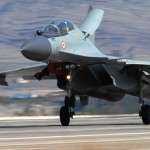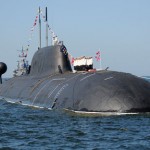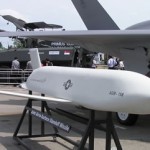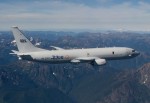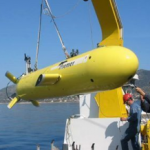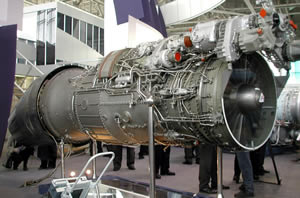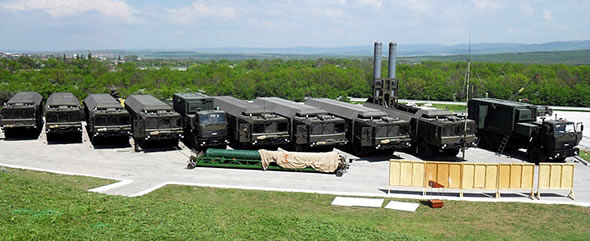úterý 27. prosince 2011
Asia Pacific Defense UAsia Pacific Defense Updatepdate
Defending The Homeland – The Future Of Japan’s And Taiwan’s Air Defense
The unsettling appearance of a Chinese aircraft carrier has created
quite a stir in the Pacific among those nations that rely heavily on the
United States for warfighting protection and military hardware. With
the Chinese carrier now underway on its second round of sea trials, the
Pacific community is looking with increased urgency to improve air
defenses. Taiwan and Japan in particular are in critical need of an
upgrade to their existing air-superiority fighter forces.
Earlier this year, President Obama rejected Taiwan’s request to purchase as many as 66 new F-16 C/D aircraft to replace its aging fleet of F-16 A/B and F-5 fighters. The Obama administration has instead offered a deal to upgrade Taiwan’s existing fleet of the A/B versions of the F-16. This $5.85 billion upgrade will give the older F-16s most of the advanced capabilities of the C/D versions. With the upgrade, the older F-16s would receive enhanced radar, avionics, and weaponry. Taiwan was quick to publicly welcome the offer of the upgrade.
Unfortunately, the planned upgrade will do little to alleviate
the problem of keeping the Taiwanese F-16 fleet in the air for any
length of time. The F-16s and F-5s now in operation in Taiwan are tired
aircraft that have already been in service far longer than their
designed lifespan. The F-16s date back as far as 1992 and the F-5s are
Vietnam-era aircraft that are of little use except as trainers. Taiwan
has been plagued by a series of aircraft crashes and safety stand downs
that are usually indicative of aging airframes that require continuous
maintenance and can, over time, render the aircraft unsafe for normal
operation.
Taiwan’s efforts to manufacture an air-superiority fighter of its own making yielded 130 aircraft that proved to be less capable than desired. With the assistance of American defense contractors, the initial concept was an idea that held a reasonable promise of delivering a homegrown fighter capable of meeting Taiwan’s air defense needs. Unfortunately, the project hit a snag when Taiwan was forced to exclude the high-thrust engines needed to make the aircraft a real warfighting threat. Enhanced models of the fighter are just now becoming a reality and may yet provide Taiwan with a viable homegrown air-superiority fighter.
Taiwan has also expressed a sincere interest in acquiring the new F-35 multirole fighter. There is very little likelihood that the F-35 will become part of the Taiwanese air fleet any time soon.
With the acquisition of new F-16s not likely in the short term and procurement of the F-35 little more than a dream, Taiwan’s ability to defend its air space against a determined Chinese aerial onslaught is critically limited, but the Taiwanese might have the capacity to give the Chinese a nasty reception in the event of open hostilities.
While Taiwan is forced to take whatever it can get to enhance its air defense capabilities, Japan remains undecided about the aircraft it wants as a replacement for its well-worn force of F-4EJ, F-2, and F-15J fighters. Recent accidents and groundings have exposed the Japanese air fleet’s maintenance nightmare of keeping its fighter aircraft aloft. Unlike Taiwan, Japan as a sovereign nation is not hogtied by the same political restrictions and second guessing facing Taiwan and is free to contract for the aircraft best suited to meet its air defense needs. That is, except for Lockheed Martin’s F-22 Raptor, an aircraft the United States is not yet willing to share.
Japan’s F-4EJ Kai Phantoms have been in service since the early 1970s and have certainly outlived their operational usefulness. The F-15Js have been operational since the early 1980s and are definitely showing their age. Production of the F-2 came to an end when the last aircraft was delivered on September 27 of this year. The air fleet is worn, outdated, and outclassed.
In 2010 both China and Russia intensified their testing of Japanese air defenses with hundreds of intrusions into Japanese air space – the largest number of unauthorized flights since 1991. The Japanese Air Self Defense Force (JASDF) was pushed to the limit in its efforts to meet this challenge in 2010 and the results were not cause for celebration. The intensity of the JASDF air operations further aggravated the problem of keeping aging aircraft operational.
With China recently unveiling its J-20 multipurpose fighter, reported to possess stealth technology and capability, and Russia announcing a joint project with India to develop its fifth-generation Sukhoi T-50 fighter, Japan is distressed to learn just how far behind potential adversaries its existing fighter defense force really is. The carrier sea trials being conducted by China have heightened the Japanese sense of being vulnerable to a host of very capable and very dangerous enemies.
Unlike Taiwan, Japan is in the enviable position of being free to choose a replacement fighter that can stand up to the Chinese challenge. Japan has narrowed the candidates she considers best able to defend her air space to three aircraft, the Boeing F/A-18E/F Super Hornet, Lockheed Martin’s F-35 Joint Strike Fighter (JSF), and BAE System’s Eurofighter Typhoon.
One key criterion the Japanese government is using to determine the replacement to be chosen is the degree of manufacture/assembly the parent company will allow to be performed in Japan. All three manufacturers have indicated a willingness to offer Japan a licensing agreement giving Japan a specified level of manufacturing/assembly authority, but each is offering a slightly different level of authority.
The Japanese government has not made any announcement designating the aircraft to be purchased, but an announcement is expected late this month or early next month.
Most observers believe that the F-35 Lightning II is the replacement most likely to be selected as it is the most technologically advanced of the three and the most capable. Japan has historically opted for the most sophisticated weaponry available. However, the F-35 has experienced numerous production and testing delays and it carries a very hefty price tag. The F/A-18E/F Super Hornet is a very capable aircraft with an exceptional performance record and a much more palatable price tag. The Eurofighter Typhoon is also capable, but Japan has never bought a European warplane before and the United States must certainly be pressuring Japan to stay with an American aircraft. Some observers have also raised doubts about the Typhoons ability to be fully integrated into a largely American-equipped force. They are concerned that the Typhoon would unnecessarily complicate a maintenance and supply chain that is, by its very nature, already complicated enough.
While the F-35 appears to be the best fighter for the job, cost is a major consideration as well. Japan is burdened with debt that exceeds 200 percent of GDP and is continuing to increase. Japan’s leaders will have to decide between getting the best at great cost or getting a solid performer for a much lower cost. Which is now more important for Japan, the very best fighter available or a good first-class fighter that won’t break the piggybank?
About the author: Richard D. Dudley
U.S. Marine Corps Maj. (Ret) Richard D. Dudley has been serving with the Marine Corps in active duty for 26 years, rising from Private (E1) to retire as a Major (O4) with experience in numerous shipboard and shore-based deployments. During his service Maj. Dudley has specialized in logistics and support. For the past 15 years he is living in Japan serving as an independent sales consultant/local area manager with the Marine Corps Air Station in Japan.
Earlier this year, President Obama rejected Taiwan’s request to purchase as many as 66 new F-16 C/D aircraft to replace its aging fleet of F-16 A/B and F-5 fighters. The Obama administration has instead offered a deal to upgrade Taiwan’s existing fleet of the A/B versions of the F-16. This $5.85 billion upgrade will give the older F-16s most of the advanced capabilities of the C/D versions. With the upgrade, the older F-16s would receive enhanced radar, avionics, and weaponry. Taiwan was quick to publicly welcome the offer of the upgrade.
Taiwan’s efforts to manufacture an air-superiority fighter of its own making yielded 130 aircraft that proved to be less capable than desired. With the assistance of American defense contractors, the initial concept was an idea that held a reasonable promise of delivering a homegrown fighter capable of meeting Taiwan’s air defense needs. Unfortunately, the project hit a snag when Taiwan was forced to exclude the high-thrust engines needed to make the aircraft a real warfighting threat. Enhanced models of the fighter are just now becoming a reality and may yet provide Taiwan with a viable homegrown air-superiority fighter.
Taiwan has also expressed a sincere interest in acquiring the new F-35 multirole fighter. There is very little likelihood that the F-35 will become part of the Taiwanese air fleet any time soon.
With the acquisition of new F-16s not likely in the short term and procurement of the F-35 little more than a dream, Taiwan’s ability to defend its air space against a determined Chinese aerial onslaught is critically limited, but the Taiwanese might have the capacity to give the Chinese a nasty reception in the event of open hostilities.
While Taiwan is forced to take whatever it can get to enhance its air defense capabilities, Japan remains undecided about the aircraft it wants as a replacement for its well-worn force of F-4EJ, F-2, and F-15J fighters. Recent accidents and groundings have exposed the Japanese air fleet’s maintenance nightmare of keeping its fighter aircraft aloft. Unlike Taiwan, Japan as a sovereign nation is not hogtied by the same political restrictions and second guessing facing Taiwan and is free to contract for the aircraft best suited to meet its air defense needs. That is, except for Lockheed Martin’s F-22 Raptor, an aircraft the United States is not yet willing to share.
Japan’s F-4EJ Kai Phantoms have been in service since the early 1970s and have certainly outlived their operational usefulness. The F-15Js have been operational since the early 1980s and are definitely showing their age. Production of the F-2 came to an end when the last aircraft was delivered on September 27 of this year. The air fleet is worn, outdated, and outclassed.
In 2010 both China and Russia intensified their testing of Japanese air defenses with hundreds of intrusions into Japanese air space – the largest number of unauthorized flights since 1991. The Japanese Air Self Defense Force (JASDF) was pushed to the limit in its efforts to meet this challenge in 2010 and the results were not cause for celebration. The intensity of the JASDF air operations further aggravated the problem of keeping aging aircraft operational.
With China recently unveiling its J-20 multipurpose fighter, reported to possess stealth technology and capability, and Russia announcing a joint project with India to develop its fifth-generation Sukhoi T-50 fighter, Japan is distressed to learn just how far behind potential adversaries its existing fighter defense force really is. The carrier sea trials being conducted by China have heightened the Japanese sense of being vulnerable to a host of very capable and very dangerous enemies.
Unlike Taiwan, Japan is in the enviable position of being free to choose a replacement fighter that can stand up to the Chinese challenge. Japan has narrowed the candidates she considers best able to defend her air space to three aircraft, the Boeing F/A-18E/F Super Hornet, Lockheed Martin’s F-35 Joint Strike Fighter (JSF), and BAE System’s Eurofighter Typhoon.
One key criterion the Japanese government is using to determine the replacement to be chosen is the degree of manufacture/assembly the parent company will allow to be performed in Japan. All three manufacturers have indicated a willingness to offer Japan a licensing agreement giving Japan a specified level of manufacturing/assembly authority, but each is offering a slightly different level of authority.
The Japanese government has not made any announcement designating the aircraft to be purchased, but an announcement is expected late this month or early next month.
Most observers believe that the F-35 Lightning II is the replacement most likely to be selected as it is the most technologically advanced of the three and the most capable. Japan has historically opted for the most sophisticated weaponry available. However, the F-35 has experienced numerous production and testing delays and it carries a very hefty price tag. The F/A-18E/F Super Hornet is a very capable aircraft with an exceptional performance record and a much more palatable price tag. The Eurofighter Typhoon is also capable, but Japan has never bought a European warplane before and the United States must certainly be pressuring Japan to stay with an American aircraft. Some observers have also raised doubts about the Typhoons ability to be fully integrated into a largely American-equipped force. They are concerned that the Typhoon would unnecessarily complicate a maintenance and supply chain that is, by its very nature, already complicated enough.
While the F-35 appears to be the best fighter for the job, cost is a major consideration as well. Japan is burdened with debt that exceeds 200 percent of GDP and is continuing to increase. Japan’s leaders will have to decide between getting the best at great cost or getting a solid performer for a much lower cost. Which is now more important for Japan, the very best fighter available or a good first-class fighter that won’t break the piggybank?
About the author: Richard D. Dudley
U.S. Marine Corps Maj. (Ret) Richard D. Dudley has been serving with the Marine Corps in active duty for 26 years, rising from Private (E1) to retire as a Major (O4) with experience in numerous shipboard and shore-based deployments. During his service Maj. Dudley has specialized in logistics and support. For the past 15 years he is living in Japan serving as an independent sales consultant/local area manager with the Marine Corps Air Station in Japan.
The U.S. Air force has awarded General Atomics a contract to build a third prototype of the stealthy Predator C Avenger unmanned aircraft. General Atomics has already built two such aircraft and is planning to build two more, at least one is now being funded by the U.S. Government. According to David A. Fulghum of Aviation Week, these new ‘Avenger’ versions will be more powerful and will carry more payloads than the first two prototype competed in 2009. A second Avenger flew for the first time in April 2010. The Air Force has allocated $15 million for the first aircraft but the program is expected to grow in size. General Atomics informed the Air Force it is ready to quickly ramp up production if the Air Force or other government agencies will order more planes. The procurement is overseen by the U.S. Air Force’s secretive Big Safari, a special, rapid-acquisition organization. The Air Force plans to send this aircraft to Afghanistan, where it will be used for evaluation of ‘next-generation UAS sensors, weapons and tactics, techniques and procedures’, enabling the service to accelerate fielding of these advanced capabilities to the area of operations. The tests will also help determining the requirement for plane’s radar signature (stealth) reduction. Avenger is designed to perform high-speed, long-endurance, covert, multi-mission Intelligence, Surveillance, and Reconnaissance (ISR) and precision-strike missions over land or sea. It can carry a variety of internal weapons loads, including the 2,000 lb Joint Direct Attack Munition (JDAM), an Electro-optical/Infrared (EO/IR) sensor, and an all-weather GA-ASI Lynx Synthetic Aperture Radar/Ground Moving Target Indicator (SAR/GMTI). According to General Atomics, a recce system based on Lockheed Martin’s F-35 FLIR is currently being evaluated, as well as an in-house full-motion video sensor. To maintain the clean, stealthy underside, the Avenger would probably rely on specialized integral, conformal or retractable payloads, while maximizing long loiter ISR and weapons carriage capabilities. The Predator has been one of the most successful weapon in the Drone war the CIA has launched against international terrorist targets in Asia, the Middle east and Africa. A new and more capable Predator “C-plus”, with larger payload capacity for multiple, heavier sensors and precision guided weapons, could further enhance these capabilities, opening wider operational capabilities for operations in contested airspace. Fulghum comments that an Air Forces procurement of off the shelf drone could relieve the Pentagon of having to commit to a procurement of a new program of record for ‘MX’, “in a budget environment that is guaranteed to quash new programs.” The Predator C/Avenger has also been considered for a future U.S Navy carrier based ISR platform known as UCLAAS. The decision was made public days after the loss of another stealthy drone, the RQ-170 Sentinel over Iran. However, according to Fulghum, the new announcement is irrelevant to the current incident. The Air Force planned to award the contract in November 2011, but budget complications have kept in pending. Officials said the project was underway before the loss of a reduced signature UAV near Kashmar in northeastern Iran Dec. 4.
The Australian Defence has selected Hawkei light tactical vehicle
design from Thales Australia as the preferred design for LAND 121 Phase
4.
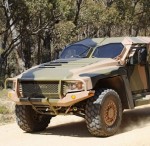 Subject to successful testing of the vehicles, final Government
approval of the project is expected in 2015, and production work could
potentially commence in Australia as early as 2016. Part of Project
Overlander, the acquisition of 1,300 modern, protected light tactical
vehicles represent a $1.5 billion part of the $7.5 billion project. The
selection of an indigenous Australian design derails previous plans to
join the U.S. Joint Light Tactical Vehicle program, which Australia has
been part of in recent years. ‘Defence will continue to monitor progress
of the US JLTV program’ the announcement said, but no additional
funding commitments have been made at this stage.
Subject to successful testing of the vehicles, final Government
approval of the project is expected in 2015, and production work could
potentially commence in Australia as early as 2016. Part of Project
Overlander, the acquisition of 1,300 modern, protected light tactical
vehicles represent a $1.5 billion part of the $7.5 billion project. The
selection of an indigenous Australian design derails previous plans to
join the U.S. Joint Light Tactical Vehicle program, which Australia has
been part of in recent years. ‘Defence will continue to monitor progress
of the US JLTV program’ the announcement said, but no additional
funding commitments have been made at this stage.
Australia evaluated two candidates for this program – the
Hawkei and Ocelot, provided by Force Protection International. The
Government required the vehicle to be manufactured in Australia, and
both contenders have relied on local subsidiaries and subcontractors to
fulfill this requirement.
The next stage in the program will
include funding for further development and testing of the Hawkei,
including the manufacture of prototype vehicles. Thales designed this
vehicle specifically to meet Australian specification; the Israeli armor
protection expert Plasan has joined as a team member, to provide the protection suite for the vehicle.
Thales
Australia is currently manufacturing the Bushmaster Protected Mobility
Vehicles at its factory in Bendigo. This manufacturing capability, and
the skills of the workforce, is an important national security
capability. On current plans, manufacture of Bushmasters at Bendigois
expected to be completed before the end of 2013, in time to begin serial
production of the new vehicle.
In order to retain critical skills
in Bendigo while the design of the Hawkei is finalized and proven, the
production of additional Bushmaster vehicles is being considered. “It is
very important that we keep that industrial technical development
capacity in Bendigo, and as the materials indicate we’ll be in
discussions with Thales so far as additional Bushmasters are concerned
to ensure that we retain that industrial capacity linked to the
development of the Hawkei.” said Minister for Defense & Defense
Material, Stephen Smith.
The next stage in the program will include funding for further development and testing of the Hawkei, including the manufacture of prototype vehicles. Thales designed this vehicle specifically to meet Australian specification; the Israeli armor protection expert Plasan has joined as a team member, to provide the protection suite for the vehicle.
Thales Australia is currently manufacturing the Bushmaster Protected Mobility Vehicles at its factory in Bendigo. This manufacturing capability, and the skills of the workforce, is an important national security capability. On current plans, manufacture of Bushmasters at Bendigois expected to be completed before the end of 2013, in time to begin serial production of the new vehicle.
In order to retain critical skills in Bendigo while the design of the Hawkei is finalized and proven, the production of additional Bushmaster vehicles is being considered. “It is very important that we keep that industrial technical development capacity in Bendigo, and as the materials indicate we’ll be in discussions with Thales so far as additional Bushmasters are concerned to ensure that we retain that industrial capacity linked to the development of the Hawkei.” said Minister for Defense & Defense Material, Stephen Smith.
U.S. Air Force to Receive a More Powerful ‘Predator C Plus ’
The U.S. Air force has awarded General Atomics a contract to build a third prototype of the stealthy Predator C Avenger unmanned aircraft. General Atomics has already built two such aircraft and is planning to build two more, at least one is now being funded by the U.S. Government. According to David A. Fulghum of Aviation Week, these new ‘Avenger’ versions will be more powerful and will carry more payloads than the first two prototype competed in 2009. A second Avenger flew for the first time in April 2010. The Air Force has allocated $15 million for the first aircraft but the program is expected to grow in size.
The Air Force plans to send this aircraft to Afghanistan, where it will be used for evaluation of ‘next-generation UAS sensors, weapons and tactics, techniques and procedures’, enabling the service to accelerate fielding of these advanced capabilities to the area of operations. The tests will also help determining the requirement for plane’s radar signature (stealth) reduction.
Avenger is designed to perform high-speed, long-endurance, covert, multi-mission Intelligence, Surveillance, and Reconnaissance (ISR) and precision-strike missions over land or sea. It can carry a variety of internal weapons loads, including the 2,000 lb Joint Direct Attack Munition (JDAM), an Electro-optical/Infrared (EO/IR) sensor, and an all-weather GA-ASI Lynx Synthetic Aperture Radar/Ground Moving Target Indicator (SAR/GMTI). According to General Atomics, a recce system based on Lockheed Martin’s F-35 FLIR is currently being evaluated, as well as an in-house full-motion video sensor. To maintain the clean, stealthy underside, the Avenger would probably rely on specialized integral, conformal or retractable payloads, while maximizing long loiter ISR and weapons carriage capabilities.
The Predator has been one of the most successful weapon in the Drone war the CIA has launched against international terrorist targets in Asia, the Middle east and Africa. A new and more capable Predator “C-plus”, with larger payload capacity for multiple, heavier sensors and precision guided weapons, could further enhance these capabilities, opening wider operational capabilities for operations in contested airspace. Fulghum comments that an Air Forces procurement of off the shelf drone could relieve the Pentagon of having to commit to a procurement of a new program of record for ‘MX’, “in a budget environment that is guaranteed to quash new programs.” The Predator C/Avenger has also been considered for a future U.S Navy carrier based ISR platform known as UCLAAS.
The decision was made public days after the loss of another stealthy drone, the RQ-170 Sentinel over Iran. However, according to Fulghum, the new announcement is irrelevant to the current incident. The Air Force planned to award the contract in November 2011, but budget complications have kept in pending. Officials said the project was underway before the loss of a reduced signature UAV near Kashmar in northeastern Iran Dec. 4.
Cyber Soldiers: Hackers in Fatigues
Earlier this month the U.S. Army Intelligence and Security Command activated the 780th Military Intelligence Brigade, with two battalions – Fort Meade located 781st MI Battalion and the 782nd MI, located at Fort Gordon, Ga. The new brigade will support the U.S. and Army Cyber Commands conducting signals intelligence, computer network operations, and when directed, offensive operations, in support of DOD, Army and interagency operations worldwide, while denying the same to its adversaries. The intent is to support General Keith B. Alexander, commander of USCYBERCOM and director of the NSA.
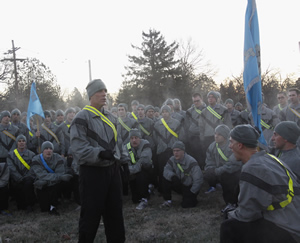
Col.
Jonathan Sweet, commander, 780th Military Intelligence Brigade,
addresses his troops following their first official brigade run,
conducted Dec. 2, 2011, following the unit's activation ceremony, which
was held Dec. 1, at Friedman Auditorium, Fort George G. Meade, Md.
Photo: U.S. Army by Tina Miles
Considering that the internet made its first public appearance not long ago, in the 1980s, it is astonishing how fast we have arrived at “Star Trek” like enemy computer attack events. Was Lt. Uhura, originally a communications officer from a 1960 television program, the precursor of the current C4ISR expert and cyber soldier? In Star Trek, due to her technical and computing capabilities, she proved indispensable in most of the episodes against sophisticated and complex enemies who mostly used malware or mechanical or robotic intelligence to attack the Federation allies. If we look at literature and films from the 1940s and on, man has always been fascinated with the power of computers against man. Current real life warfare pits man against man with the added advantage of computer war in Cyberspace.
The origin of the word “Cyberspace” is cybernetics and space. There, however, is no uniform definition. One pictures a space composed of electronic data or electric nerve-like impulses. The cyber soldier exists in this complex battlefield, where the enemy is everywhere and nowhere, and he/she is trained to navigate, understand, manipulate and control the data and anticipate the enemy so that the traditional armed forces can operate.
The ultimate goal of the cyber soldier is proactive or reactive but the intention is to prevent loss of combat advantage and avert serious personal injury or death. So while the 780 brigade cyber soldier, like his/her parallel in other countries, may be a geek, he or she is actually a specially hand-picked, meticulously trained, elite warrior who will be charged with defending his country and their allies from forceful threats in the intricate, labyrinth of Cyberspace. Military culture must adapt to this new reality where blood spill is real and nothing can be taken for granted from now on.
About the author: Lori Solberg (MBA, Adv.)
Former deputy general counsel of Rafael Advanced Defense Systems (international), Lori Solberg provides customized general and business advice to advanced technology and defense companies. She specializes in business market expansion in the defense and HLS fields worldwide as well as representation before international export control authorities.
Cheongung – a New MR-SAM for the South Korean Multi-Tier Defense System
The growing threat of missile attack by North Korea has concerned
Seoul for decades, but only recently defensive systems are showing
progress, with interceptor technology becoming available on the domestic
and world market. Last week the Agency for Defense Development (ADD) of
South Korea unveiled the Cheongung – a new medium-range Surface to air
Missile system designed to beef up the country’s air and missile
defense.
Missiles deployed by North Korea are covering the entire area
of the South, Pyongyang has deployed more than 600 short-range Scud
missiles north of the Demilitarized Zone (DMZ), with a range of 320 to
500 kilometers. In addition, 200 Rodong missiles positioned inland have a
range of 1,300 kilometers, reaching every point in the South. North
Korean Intermediate range ballistic missiles can also reach Russia,
China, Japan and Alaska.
Until recently Seoul relied primarily on
the U.S. air defense umbrella, comprising Raytheon’s latest version
MIM-23 Hawk XXI and ex-German MIM-104 Patriot PAC-2 missiles. Air and
missile defense is augmented by the Navy’s AEGIS cruisers and
destroyers, providing ad-hoc anti-missile defense.
To defend
against North Korean missiles and rocket attacks the Republic of Korea
is eying a three-tier aerial and missile defense system to integrate
radars, missile interceptors of different types through a unified battle
management system. Preliminary study on missile shield system to be
completed by year-end.
Seoul principal air defense layer operates
six batteries of Patriot PAC-2 GEM/T missiles along with 24 Hawk XXI
batteries. These assets are more capable to defend against aircraft than
hit ballistic missiles. Two missile interceptor/air defense programs
currently underway in Russia will be transferred for production in
Korea, one covering extended range and high altitude, and another
handling the middle-tier zone.
The first is the medium-range air
defense system known as KM-SAM, developed in Russia by the Almaz Design
Bureau, in association with an industry team from Korea lead by Samsung
Thales. This team included missile builder LIG Nex1 and platform
manufacturer Doosan DST. Further localization and industrialization were
done in South Korea, making the new weapon system
an indigenous program.
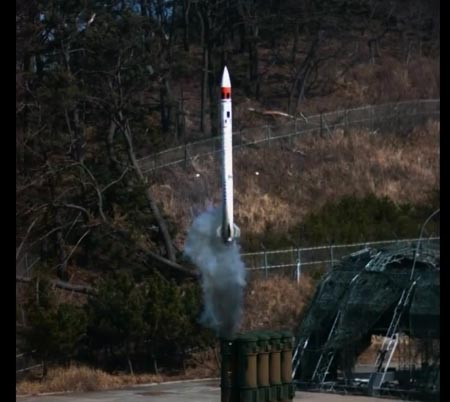 The
new SAM called ‘Cheongung’ (Iron Hawk) can intercept targets at
altitude up to 15 km and at a range of about 40 km. LIG Nex1 plans to
begin production in 2012 and according to the original schedule, begin
replacing the first MIM-23 Hawk batteries beginning 2013. Following the
induction of the new Cheongung Seoul plans to offer the missile for
export. Seoul estimates the market potential of such missiles at over
US$2.3 billion. Apparently, the Russian Company that developed the
system, Almaz Antey, thought the same as they kept the program alive
after transferring the prototypes to Korea. The Russian version known
as Vityaz could be ready to replace first generation S-300PS (5V55R)
missiles, covering a similar intercept envelope, by the end of their
service in 2015.
The
new SAM called ‘Cheongung’ (Iron Hawk) can intercept targets at
altitude up to 15 km and at a range of about 40 km. LIG Nex1 plans to
begin production in 2012 and according to the original schedule, begin
replacing the first MIM-23 Hawk batteries beginning 2013. Following the
induction of the new Cheongung Seoul plans to offer the missile for
export. Seoul estimates the market potential of such missiles at over
US$2.3 billion. Apparently, the Russian Company that developed the
system, Almaz Antey, thought the same as they kept the program alive
after transferring the prototypes to Korea. The Russian version known
as Vityaz could be ready to replace first generation S-300PS (5V55R)
missiles, covering a similar intercept envelope, by the end of their
service in 2015.
A Cheongung battery comprises a fire control
center, a multi-function radar and up to eight fire units, each carrying
eight missiles in ready to launch configuration. It is designed to
engage multiple targets simultaneously while tracking (hundred?)
additional targets. The key for this capability are the compact
multi-function radar developed by Thales-Samsung. Target data and
intercept commands are transferred to the missile just prior to firing,
with mid-course updates relayed in flight. The vertically launched
missile is designed for high maneuverability withstanding loads of up to
50g. It weighs 400 kg, and uses INS guidance with midcourse updates,
with active-homing RF seeker for terminal guidance. The multi-function
radar is a 3D plannar active array system operating in the X band, it
rotates at a rate of 40 rpm and covers up to 80 degrees in elevation.
The
upper tier interceptor will be designed intercept ballistic missiles,
offering capabilities similar to the American THAAD missile. This new
missile is expected to be based on the Russian S-400 technology; it is
designated Cheolmae 4-H, and will offer a range of 150 km and ceiling of
about 200,000 ft, offering performance levels twice superior to the
Patriot and future Cheolmae II missiles. This project is expected to
cost around $812 million.
The Korean Navy is also planning to deploy
anti-ballistic missile capability on its new KDX AEGIS destroyers.
Unlike Tokyo, that has entered the U.S. SM-3 ABM program as a
development partner, Seoul preferred to go its own way and develop its
won version of a missile interceptor under ‘Project Guardian’, at an
investment of about US$1 billion.
The baseline for Seoul’s future
the missile defense capability are two EL/M-2080 ‘Super Green Pine’
radars, ordered from Israel’s IAI Elta in 2009. The radars will be able
to detect hostile missiles 800 km away, providing missile defense assets
ample early warning for response. These radars will also integrate with
the SPY-1 radars of the AEGIS KDX destroyers to provide the situational
picture for the Korea Air and Missile Defense center (KAMD) beginning
next year.
Until recently Seoul relied primarily on the U.S. air defense umbrella, comprising Raytheon’s latest version MIM-23 Hawk XXI and ex-German MIM-104 Patriot PAC-2 missiles. Air and missile defense is augmented by the Navy’s AEGIS cruisers and destroyers, providing ad-hoc anti-missile defense.
To defend against North Korean missiles and rocket attacks the Republic of Korea is eying a three-tier aerial and missile defense system to integrate radars, missile interceptors of different types through a unified battle management system. Preliminary study on missile shield system to be completed by year-end.
Seoul principal air defense layer operates six batteries of Patriot PAC-2 GEM/T missiles along with 24 Hawk XXI batteries. These assets are more capable to defend against aircraft than hit ballistic missiles. Two missile interceptor/air defense programs currently underway in Russia will be transferred for production in Korea, one covering extended range and high altitude, and another handling the middle-tier zone.
The first is the medium-range air defense system known as KM-SAM, developed in Russia by the Almaz Design Bureau, in association with an industry team from Korea lead by Samsung Thales. This team included missile builder LIG Nex1 and platform manufacturer Doosan DST. Further localization and industrialization were done in South Korea, making the new weapon system an indigenous program.
 The
new SAM called ‘Cheongung’ (Iron Hawk) can intercept targets at
altitude up to 15 km and at a range of about 40 km. LIG Nex1 plans to
begin production in 2012 and according to the original schedule, begin
replacing the first MIM-23 Hawk batteries beginning 2013. Following the
induction of the new Cheongung Seoul plans to offer the missile for
export. Seoul estimates the market potential of such missiles at over
US$2.3 billion. Apparently, the Russian Company that developed the
system, Almaz Antey, thought the same as they kept the program alive
after transferring the prototypes to Korea. The Russian version known
as Vityaz could be ready to replace first generation S-300PS (5V55R)
missiles, covering a similar intercept envelope, by the end of their
service in 2015.
The
new SAM called ‘Cheongung’ (Iron Hawk) can intercept targets at
altitude up to 15 km and at a range of about 40 km. LIG Nex1 plans to
begin production in 2012 and according to the original schedule, begin
replacing the first MIM-23 Hawk batteries beginning 2013. Following the
induction of the new Cheongung Seoul plans to offer the missile for
export. Seoul estimates the market potential of such missiles at over
US$2.3 billion. Apparently, the Russian Company that developed the
system, Almaz Antey, thought the same as they kept the program alive
after transferring the prototypes to Korea. The Russian version known
as Vityaz could be ready to replace first generation S-300PS (5V55R)
missiles, covering a similar intercept envelope, by the end of their
service in 2015.A Cheongung battery comprises a fire control center, a multi-function radar and up to eight fire units, each carrying eight missiles in ready to launch configuration. It is designed to engage multiple targets simultaneously while tracking (hundred?) additional targets. The key for this capability are the compact multi-function radar developed by Thales-Samsung. Target data and intercept commands are transferred to the missile just prior to firing, with mid-course updates relayed in flight. The vertically launched missile is designed for high maneuverability withstanding loads of up to 50g. It weighs 400 kg, and uses INS guidance with midcourse updates, with active-homing RF seeker for terminal guidance. The multi-function radar is a 3D plannar active array system operating in the X band, it rotates at a rate of 40 rpm and covers up to 80 degrees in elevation.
The upper tier interceptor will be designed intercept ballistic missiles, offering capabilities similar to the American THAAD missile. This new missile is expected to be based on the Russian S-400 technology; it is designated Cheolmae 4-H, and will offer a range of 150 km and ceiling of about 200,000 ft, offering performance levels twice superior to the Patriot and future Cheolmae II missiles. This project is expected to cost around $812 million.
The Korean Navy is also planning to deploy anti-ballistic missile capability on its new KDX AEGIS destroyers. Unlike Tokyo, that has entered the U.S. SM-3 ABM program as a development partner, Seoul preferred to go its own way and develop its won version of a missile interceptor under ‘Project Guardian’, at an investment of about US$1 billion.
The baseline for Seoul’s future the missile defense capability are two EL/M-2080 ‘Super Green Pine’ radars, ordered from Israel’s IAI Elta in 2009. The radars will be able to detect hostile missiles 800 km away, providing missile defense assets ample early warning for response. These radars will also integrate with the SPY-1 radars of the AEGIS KDX destroyers to provide the situational picture for the Korea Air and Missile Defense center (KAMD) beginning next year.
Indian Air Force Opts for More Su-30MKI, Despite Problems
Despite recent the recent crash of a Su-30MKI, Indian Air Force stands behind its first line strike fighter, increasing the planned fleet to 272 aircraft. An order for 42 additional planes was signed yesterday (December 16, 2011) in Moscow, by Defence Secretary Shashi Kant Sharma and Russian Federal Service for Military-technical Cooperation Director MA Dmitriev. India received the first of 120 Su-30MKI fighters in 1997. Follow-on orders have increased the number to 230. The new fighters will be the first newly upgraded models of the Su-30 MKI, provided with upgraded radar, enhanced cockpit displays and avionics, and designed to carry heavier loads, including the air-launched version of the Brahmos supersonic air-to-surface missile.
These 42 new Su-30 MKI will be delivered over four years, beginning 2014. After ramping up local production in India for several years, the Su-30 MKIs are built entirely in India by the Hindustan Aeronautics Ltd (HAL), under license from the original Russian manufacturer Sukhoi.
Until
December 2011 the Su-30 MKI fleet demonstrated high reliability and
safety record despite two crashes – both in 2009, that were attributed
to pilot error (the pilot inadvertently switched-off the fly-by-wire
aircraft, the switch was placed behind the seat, clearly a design error
that claimed the lives of the two men crew). The second crash was
attributed to a foreign object ingestion.
The third crash that occurred December 13, 2011 raised for the first time a concern about the safety of the flight control system. Although there were minor incidents with the Su-30 MKI ‘fly by wire‘ system in the past, none was ended in a crash. The recent crash was different. The aircraft was relatively new, among those built by HAL India in 2009. It was on the first flight following mandatory periodical check (400 flight hours). The system gave no indication about the fault, but controls deteriorated as the plane entered oscillation that evolved and worsened over almost 20 minutes, as the pilot, Wing Commander GS Sohal fought to keep the aircraft flying. Realizing the plane was losing control, WC Sohal and his weapon system operator, Flight Lieutenant U Nautiyal ejected, sending the plane to crash near a village of Wade Bolhai. Russian manufacturer is sending an expert team to investigate the accident and come up with the necessary fixes. The cause of the first accident in 2009 was attributed to a misplacement of a critical switch.
According to sources, in October 2009, one such fighter, participating in Air Force Day fly past over Hindon, UP, got a warning of ‘fly-by-wire’ after takeoff. Immediately, the controls became “sluggish” and it started “pitching up”.
A similar incident that luckily ended safely was reported in October 2009, a month after the first crash. “During recovery and the most critical part of a flight – approach and landing – it experienced continuous oscillations, and was pitching up viciously, nearly uncontrollable,” the Sunday Standard reported, “Post-flight inspection revealed multiple failures of the ‘fly-by-wire’ system, whose quadruple redundancy backs up all parts four times, making it difficult for all to fail at once. With avionics of non-Russian origin, the Su-30MKI has been facing integration problems from the beginning.”
Following the mishape all 120 Su-30 MKI in five bases (Pune, Bareilly, Tezpur, Chabua and Jodhpur) were grounded, limited operations are to resume by Monday December 19, following performing the necessary safety checks. Another concern surfaced recently is the reliability and serviceability of the fighters’ AL-31FP thrust-vectored turbofan engines. The engine powering the Indian fighter is based on the AL-31F turbofan engine developed by Lyulka (renamed NPO Saturn) in 1981 for the Sukhoi Su-27 (Fencer) fighter. The AL-31FP is a thrust-vectoring variant of that engine, developed specifically for export Su-30 versions delivered to India (MKI) and Malaysia (MKM).
The Indian Air Force has elevated the concern of these problems, demanding quick resolution of the issues before the new contract is underway.
The third crash that occurred December 13, 2011 raised for the first time a concern about the safety of the flight control system. Although there were minor incidents with the Su-30 MKI ‘fly by wire‘ system in the past, none was ended in a crash. The recent crash was different. The aircraft was relatively new, among those built by HAL India in 2009. It was on the first flight following mandatory periodical check (400 flight hours). The system gave no indication about the fault, but controls deteriorated as the plane entered oscillation that evolved and worsened over almost 20 minutes, as the pilot, Wing Commander GS Sohal fought to keep the aircraft flying. Realizing the plane was losing control, WC Sohal and his weapon system operator, Flight Lieutenant U Nautiyal ejected, sending the plane to crash near a village of Wade Bolhai. Russian manufacturer is sending an expert team to investigate the accident and come up with the necessary fixes. The cause of the first accident in 2009 was attributed to a misplacement of a critical switch.
According to sources, in October 2009, one such fighter, participating in Air Force Day fly past over Hindon, UP, got a warning of ‘fly-by-wire’ after takeoff. Immediately, the controls became “sluggish” and it started “pitching up”.
A similar incident that luckily ended safely was reported in October 2009, a month after the first crash. “During recovery and the most critical part of a flight – approach and landing – it experienced continuous oscillations, and was pitching up viciously, nearly uncontrollable,” the Sunday Standard reported, “Post-flight inspection revealed multiple failures of the ‘fly-by-wire’ system, whose quadruple redundancy backs up all parts four times, making it difficult for all to fail at once. With avionics of non-Russian origin, the Su-30MKI has been facing integration problems from the beginning.”
Following the mishape all 120 Su-30 MKI in five bases (Pune, Bareilly, Tezpur, Chabua and Jodhpur) were grounded, limited operations are to resume by Monday December 19, following performing the necessary safety checks. Another concern surfaced recently is the reliability and serviceability of the fighters’ AL-31FP thrust-vectored turbofan engines. The engine powering the Indian fighter is based on the AL-31F turbofan engine developed by Lyulka (renamed NPO Saturn) in 1981 for the Sukhoi Su-27 (Fencer) fighter. The AL-31FP is a thrust-vectoring variant of that engine, developed specifically for export Su-30 versions delivered to India (MKI) and Malaysia (MKM).
The Indian Air Force has elevated the concern of these problems, demanding quick resolution of the issues before the new contract is underway.
Oscillations experienced by a Russian Tu-154 returned to ‘flying condition’ after 10 years in storage.
Israel Air Force Plans Inviting Foreign Air Forces to a Multi-National Air Exercise in 2013
The Israeli and Italian Air Forces on Friday completed a two-week joint training exercise involving fighter jets from both nations. The exercise involved pilots flying F-16A, F-16C and F-15Is from three Israeli squadrons, pitted against Italian Air Force pilots flying Eurofighter Typhoons and Panavia Tornado strike fighters. (Photos: courtesy of Nehemia Gershuni.) This was the second joint exercise the Italian Air Force is conducting with the Israel Air Force in the IAF Airbase in Ovda, near Eilat, flying over the Israeli air/ground and air/air training range in the southern Negev desert. A similar exercise took place two months ago at the Italian Air Force at the Decimomannu Airbase in Sardinia.
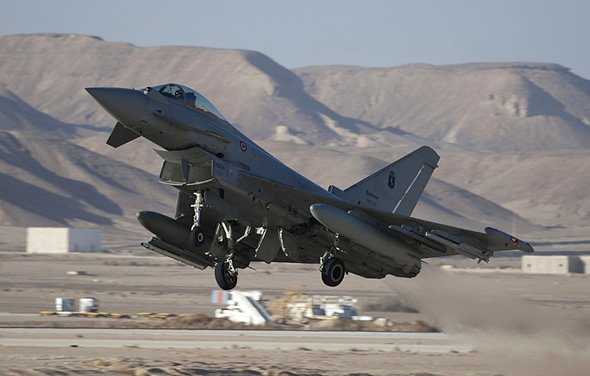
Italian
Air Force Typhoon takes off from IAF Base Ovda. The aircraft carries
two IRIS-T air/air missiles. Photo: Nehemia Gershuni, www.ngphoto.biz
Israel operates an aggressor squadron flying F-16s from the base in Ovda. For the recent exercise the squadron doubled the number of aircraft operated against the visiting aircraft, adding F-15I and F-16C fighter planes from northern IAF bases. A large instrumented combat range located north of the base is scattered with targets simulating active surface-to-air missile sites, radar emitters and electronic warfare threats realistically represented surface based threats and targets, offering modern strike fighters an excellent training environment.
The exchange is beneficial for the Israel Air Force as it offers the Israeli opportunities an important opportunity to train in dissimilar air combat, against unfamiliar combat aircraft they could meet at war. It also opens vast and unfamiliar training areas for the Israeli pilots, in neighboring countries, offering the Israeli pilots realistic and challenging missions at extended ranges – missions they canot perform realistically over their small home land.
For foreign air forces the training in Israel and with the reputable Israel Air Force provides an opportunity for pilots to gain unique experience in more realistic combat conditions they are used to in their training areas, particularly concerning electronic combat, self protection and engagement of surface-to-air weapons.
Vision-2020 – The Next Step for India’s Military Space Programs
Indian armed forces are still to get their own dedicated communication and surveillance satellites despite several years of promises and plans. Last week in written reply to a question India’s Defense Minister, A.K.Anthony stated that steps have been taken for providing
a dedicated satellite facility to the armed forces and an Integrated Space Cell has been set up for acquiring space capabilities. During the naval commanders’ conference in 2009, A K Antony had declared that in early 2010 the satellite to boost connectivity over sea would be launched. Subsequently ISRO had revised the satellite’s launch window to December 2010-March 2011, But to no avail. The repeated failures of GSLV (Geosynchronous Satellite Launch Vehicle) and indigenous cryogenic engines are major areas of concern that has bogged India’s space program. ISRO is now left with only one of the cryogenic engines imported from Russia.
For a while India has been launching dual-use civil and military satellites. One such satellite with possible military uses is the Earth Observation Technology Experiment Satellite that has a 1-meter resolution. The Polar Satellite Launch Vehicle (PSLV) put this satellite into orbit in 2001 from the Sriharikota Range. Cameras in this remote sensing satellite mapped topography across India’s northern border for potential deployment of troops and weapons by adversaries. In 2008 Indian Space Research Organization (ISRO) launched the CARTOSAT 2A and followed it up with the launch of CARTOSAT 2B in 2010.
Both these satellites are known to have military uses. CARTOSAT 2A is a robust satellite that offers area specific spot imagery for cartography and the armed forces. It carries a panchromatic camera with spatial resolution better than 1 meter and covers a swath of 9.6 km. Cartosat-2B, has spatial resolution of 2 meters and covers a swath of 30 km. per camera. For the purpose of anti submarine warfare and bathymetric studies the Indian Navy can access data from the OCEANSAT 2 satellite.
As a knee jerk reaction to the Mumbai terrorist attacks in December 2008 ISRO launched the RISAT 2, which it purchased off the shelf from Israel Aerospace Industries. Data collected by the RISAT 2 is primarily used by the National Technical Research Organization (NTRO), which controls satellite with the Military. RISAT 2 also has the unique distinction of being India’s first satellite with a Synthetic Aperture Radar (SAR), which provides night and all-weather surveillance. (The Video above is describing the Israeli EL/M-2070 SAR system used in this satellite.) It is expected that by 2014 the $25 million indigenously developed Communication-Centric Intelligence Satellite (CCI-Sat) that is being developed by the Defense Electronics and Research Laboratory under the Defense Research and Development Organization will become operational.

The
newly completed GLONASS constellation could enhance the planned IRNSS
Indian Regional Navigation Satellite System yet to be deployed. Photo:
Reshetnev
The military and civil need for a countrywide GPS and associated applications is also upsetting India’s space program. A deal with Russia on its Global Navigation Satellite System (Glonass) satellites would mean easy access to the constellation.
One transponder could operate on a military communication frequency to support the air force network.ISRO has deliberated an Indian Regional Navigational Satellite GPS System (IRNSS) of seven satellites.
The constellation and ground support will be ready by 2014. Three satellites will be in geostationary orbit (34, 83 and 132 deg. E. Long.) over the Indian Ocean. Missile targeting could be an important military application for the constellation. The IRNSS will offer a customary positioning service and a restricted service, one in the L5 band and the other in S-band. Possibly by 2012 the IRNSS could be incorporated into the Russian Navigation Information System-Glonass system for hybrid applications. However, with no early launch in sight of the GSLV, talk is gaining ground that India should consider a foreign launcher for its GSAT-7 series of military satellites.
About the author: Debajit Sarkar
Debajit Sarkar is an Aerospace and Defense analyst and subject expert specializing in UVS, and smart weapons. In his consulting work Sarkar covered a broad range of international topics, including unmanned aerial systems and autonomous ground systems, 4+/5 Generation Fighters and stealth technology, electronic warfare, radar systems and more. Debajit Sarkar is living in Hyderabad India.
Japan Formally Announces F-35 Selection
Japan formally announced today the selection of the F-35 for its future F-X fighter. Tokyo will receive 42 F-35 Lightning II multirole stealth fighters, to be built by Lockheed Martin, replacing the aging fleet of F-4s, F-2s, and F-15s flying with the Japan Air Self Defense Force (JASDF). It is expected a significant part of the aircraft assembly will be done in Japan, with the country’s leading aerospace industries Mitsubishi Heavy Industries and IHI Corporation having a major role in the production of the aircraft and its engine.Lockheed martin has indicated to offer significant work share to local subcontractors. Japan has considered three options for its F-X program – the Eurofighter Typhoon, an enhanced version of the Boeing F/A-18E/F and the F-35A.
Japan’s Yomiuri newspaper is reporting that Japan will prepare a budget that will include the purchase of four aircraft in 2012 with deliveries tentatively scheduled to begin in 2016. Lockheed Martin confirmed it expects such contract within Japan’s fiscal year 2012 beginning April 2012. The total cost of the acquisition could add up to as much as $8 billion. Although Japan is currently a major air power in the Pacific with some 362 fighters, the aircraft now in operation are suffering from age, overwork, and maintenance challenges. Japanese authorities have been seeking a viable replacement for several years.
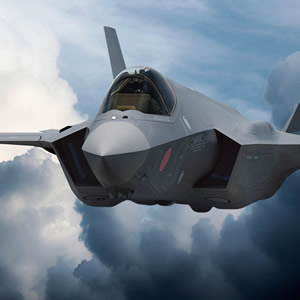
Concept vision of the F-35J for Japan
Finland has removed a cargo of 69 missiles found aboard a merchant ship that docked in the country and allowed the vessel to leave, transport safety officials said Monday. The Thor Liberty was detained on December 15 in Kotka, southeast Finland, and was later found to be carrying 150 tons of explosive material, as well as the surface-to-air Patriot missiles and missile propellant charges. "A Trafi check on 26.12.2011 has revealed that the improperly loaded explosive material has been offloaded from the vessel, with the exception of two properly loaded containers, and the detention order has been lifted," the Finnish Transport Safety Authority Trafi said in a statement. However Trafi noted that the ship was still unable to continue on its journey since Finnish customs had placed the Ukrainian captain and first mate under a travel ban pending an investigation into the missiles. Trafi added that customs had also impounded the explosives still on board the ship in two containers. The missiles, discovered Wednesday on the British-registered ship, were bound for the Chinese port city of Shanghai, according to Finnish police.1 Finnish customs are investigating the case as one of illegal export of defence material. A German defence ministry spokesman said the Patriot missiles, produced by US firm Raytheon, came from the German military and were destined for South Korea. He said it was a "legal sale on the basis of an accord between two states at the government level". He said the transaction had received an official export authorisation and was reported to customs authorities. However Finland said Friday it had not received the paperwork required from Germany.
The head of US Central Command urged greater trust and communications with the Pakistani military on Monday amid a diplomatic crisis after US air strikes killed 24 Pakistani soldiers last month.
General James Mattis made his recommendations after his command, which oversees US military operations across a wide swath of North Africa, the Middle East and Central Asia, released the results of its own investigation into the November 25-26 incident.
A joint US-NATO investigation unveiled last week portrayed a disastrous spate of errors and botched communication in which both sides failed to inform the other about their operational plans or the location of troops.
"The strongest take-away from this incident is the fundamental fact that we must improve border coordination and this requires a foundational level of trust on both sides of the border," Mattis said in a statement.
The deadliest single cross-border attack of the 10-year war in Afghanistan, the strike has plunged the precarious Pakistani-US alliance to its lowest ebb in a decade with both sides in dispute about the precise sequence of events.
Islamabad rejected the earlier US inquiry after the Americans insisted their troops responded only after coming under heavy machine-gun and mortar fire.
It also refused to take part in the probe and instead sought a formal apology from US President Barack Obama, dissatisfied with condolences and expressions of regret from the Americans.
Although the US-NATO probe acknowledged the Americans had relayed "incorrect mapping information" to a Pakistani liaison officer that gave the wrong location for Pakistani troops at border outposts, the CENTCOM report made no mention of discipline of US or NATO personnel.
But Mattis directed NATO's International Security Assistance Force (ISAF) commander General John Allen to take a number of corrective actions to improve the now-moribund relationship with Islamabad, including fostering "improved, mutual trust" between forces working in the mostly lawless border areas.
Troops should also "clarify authorities, responsibilities, and standard operating procedures" in the area as well as conduct formal exercises and drills to improve coordination and reduce chances of conflict.
Mattis also called for "full disclosure of all border area facilities and installations" on both sides of the border, with updates using a shared database and map as well as organizing coordination visits.
His comments came as The New York Times reported that the United States is bracing for a limited counterterrorism alliance with Pakistan, as a deterioration in ties complicates the ability to launch attacks against extremists and move supplies into Afghanistan.
"We've closed the chapter on the post-9/11 period," the Times quoted a senior US official as saying. "Pakistan has told us very clearly that they are re-evaluating the entire relationship."
The shift means the United States will be forced to restrict drone strikes, limit the number of its spies and soldiers on the ground and spend more to transport supplies through Pakistan to allied troops in Afghanistan, according to the report. It said US said to Pakistan would also drop sharply.
A Los Angeles Times report over the weekend said the CIA has already suspended drone missile strikes on gatherings of low-ranking militants in Pakistan due to tensions with Islamabad.
Finland says missile ship free to leave
Finland has removed a cargo of 69 missiles found aboard a merchant ship that docked in the country and allowed the vessel to leave, transport safety officials said Monday.
The Thor Liberty was detained on December 15 in Kotka, southeast Finland, and was later found to be carrying 150 tons of explosive material, as well as the surface-to-air Patriot missiles and missile propellant charges.
"A Trafi check on 26.12.2011 has revealed that the improperly loaded explosive material has been offloaded from the vessel, with the exception of two properly loaded containers, and the detention order has been lifted," the Finnish Transport Safety Authority Trafi said in a statement.
However Trafi noted that the ship was still unable to continue on its journey since Finnish customs had placed the Ukrainian captain and first mate under a travel ban pending an investigation into the missiles.
Trafi added that customs had also impounded the explosives still on board the ship in two containers.
The missiles, discovered Wednesday on the British-registered ship, were bound for the Chinese port city of Shanghai, according to Finnish police.1
Finnish customs are investigating the case as one of illegal export of defence material.
A German defence ministry spokesman said the Patriot missiles, produced by US firm Raytheon, came from the German military and were destined for South Korea.
He said it was a "legal sale on the basis of an accord between two states at the government level". He said the transaction had received an official export authorisation and was reported to customs authorities.
However Finland said Friday it had not received the paperwork required from Germany.
Looking forward into what lies ahead for us in 2012, Zscaler offers predictions for the upcoming threat landscape. 1. Mobile: With WebOS now officially an orphan, Blackberry OS racing to the grave and Windows Mobile still trying to get ready for the party, the victors can be crowned – iOS and Android have won. The interesting part of the race is about to begin, namely who has the best security model. Will it be Apple’s draconian, ‘we control everything’ or Google’s happy-go-lucky ‘come on in, everyone’s invited’ approach? Prediction: The ‘do no evil’ company will struggle mightily to keep evil applications out of their App Marketplace. In an effort to avoid being to mobile what Windows is to PCs (a breeding ground for malware), Google will subtly make Android less open to both partners and developers. They will also announce an initiative to increase security screening for applications before deployment in the App Marketplace. Apple on the other hand will have comparatively few malicious apps to deal with, but at least three major OS flaws that impact all users (and makes the jailbreak team happy). Apple will address the vulnerabilities several days late and apologize to no one. 2. Enterprise: Thanks to marketing teams across the globe, APT (Advanced Persistent Threat) has become a meaningless buzzword in the security lexicon. Let’s therefore ditch that term and instead focus on targeted attacks, specifically those focused on enterprises with the goal of corporate espionage or to inflict financial damage. Many praised Google for coming forward in January 2010 to reveal that they and others had been the victim of a sophisticated targeted attack, likely originating from China. Many in the public mistakenly assumed that this was a new and previously unseen event on the security stage. What was new about it was the openness displayed by Google in discussing the situation. Prediction: The term ‘APT’ will go the way of ‘eCommerce’ and the Dodo bird, but stories of targeted attacks against enterprises will rise tenfold in the media. This will be a reflection of increased activity by attackers as they broaden their reach to smaller companies and decisions by corporate council to disclose details of an attack rather than to suppress the information and risk litigation for trying to cover up such activity. 3. Web: Want to know a secret for making security predictions? Take a look at what was being discussed at security conferences 2-3 years ago. At Black Hat DC 2009, I discussed the dangers of persistent web browser storage. One of the key technologies that will be taking browser storage to the next level is HTML5. In 2009, HTML5 apps were few and far between. Thanks in large part to mobile browsers, HTML5 is now much more mainstream. As with any new technology, developers are quickly rushing to play with the new kid on the block and publishing their goods, without taking the time to understand the security implications. Prediction: We’ll see an increasing number of web application vulnerabilities in HTML5 apps, not because the technologies behind it are insecure, but because it is not well understood from a security perspective. 4. Hardware: Security in the hardware space is at least ten years behind security in the software industry. This isn’t so much a reflection of the good work being done in software as it is the reality of software vendors being forced to address an issue that was impacting business. Thanks to the efforts of many great researchers investing countless hours doing QA work that should have been done long before products hit the shelf, today most major security vendors have no choice but to employ security response teams and take vulnerability disclosure very seriously. Hardware vendors simply haven’t faced the same scrutiny, but that’s changing. This year at Blackhat, I spoke about the sad state of embedded web servers and recently researchers at Columbia University discussed the ability to remotely cause physical damage to HP printers due to security flaws. Prediction: Hardware vendors will get a wake-up call as researchers shift their efforts to hardware and party like it’s 1999. 5. Social: The majority of malicious activity surrounding social networks today primarily involves unwanted or nuisance traffic as opposed to attacks that lead to a fully compromised machine. We’re seeing an increase in likejacking and self-inflicted JavaScript injection attacks that have the same overall goal – drive web traffic or prompt software downloads that can earn the scammer a few cents per click. Social networks such as Facebook are of value to more serious criminals, but mainly for reconnaissance during targeted attacks. They are a great resource for learning background information about an individual and uncovering relationships, all of which can be of great value for social engineering. We’re not however, commonly seeing the communication aspects of social networks used to deliver malicious payloads directly to victims or investments in uncovering web application vulnerabilities used to compromise end user machines as opposed to spreading the aforementioned scams. Prediction: Attackers will raise the bar and leverage social networks for more sophisticated attacks, the goal of which will be full compromise as opposed to marketing financial scams.
Online "hacktivist" group Anonymous claimed Sunday it had stolen a trove of emails and credit card information from US-based security firm Stratfor's clients, and vowed additional attacks.
Hackers provided a link on Twitter to what they said was Stratfor's private client list, which included the US Defense Department, Army, Air Force, law enforcement agencies, top security contractors and technology firms like Apple and Microsoft.
They also posted images online claiming to show receipts from donations made by the hackers on behalf of some of Stratfor's clients by using their credit card data.
The hackers said they were able to obtain the information in part because Stratfor did not encrypt it, which could prove a major source of embarrassment to the global intelligence firm.
"Anonymous hacks and discredits @STRATFOR intelligence company," Twitter user YourAnonNews wrote on the micro-blogging website. "Maybe they should learn what encryption is."
An alleged Anonymous hacker who uses the Twitter handle anonymouSabu claimed that over 90,000 credit cards from law enforcement, journalists and the intelligence community had been leaked and used for "over a million dollars" in donations.
A widely distributed hacking message posted online, however, mentioned just 4,000 credit cards, passwords and home addresses.
Among the donations shown was a $494 payment on behalf of the Department of Defense for textbooks, a school uniform and food crisis education provided by charity CARE for impoverished girls and women.
A $180 payment was allegedly made to the American Red Cross on behalf of a Department of Homeland Security official, and was signed "Thank you! Department of Homeland Security."
Another $200 payment was made to the American Red Cross on behalf of a Texas Department of Banking official.
In an email to its members, Stratfor said it had suspended its email and servers after learning the website was hacked.
In a subsequent message, it said the disclosure was "merely a list of some of the members that have purchased our publications and does not comprise a list of individuals or entities that have a relationship with Stratfor."
Stratfor said it had contracted a "leading identity theft protection and monitoring service" and urged members to take their own precautions, including notifying banks about any suspicious credit card activity.
"We are on top of the situation and will continue to be vigilant in our implementation of the latest, and most comprehensive, data security measures," said the email, signed by chief executive George Friedman.
"We are working to restore access to our website and continuing to work closely with law enforcement," Friedman wrote, adding his "sincerest apologies for this unfortunate incident."
The company's website was still down as of early Sunday evening.
Wishing a "Merry LulzXmas" to all -- in an apparent reference to Anonymous-affiliated group Lulz Security -- Anonymous vowed to go after celebrities Justin Bieber, Lady Gaga, Kim Kardashian and Taylor Swift.
Anonymous has been involved in scores of hacking exploits, including the recent defacing of a website of Syria's Ministry of Defense to protest a bloody crackdown on anti-government protesters.
Last year, the shadowy group launched retaliatory attacks on companies perceived to be enemies of the anti-secrecy website WikiLeaks.
neděle 11. prosince 2011
Kvant 1L222 Avtobaza Electronic Intelligence (ELINT) system
Russia has transferred a number of Kvant 1L222 Avtobaza Electronic Intelligence (ELINT) systems to Iran in October, RIA Novosti news agency announced. Each 1L222 system includes an passive ELINT signals interception system and a jamming module capable of disrupting airborne radars including fire control radars, terrain following radars and ground mapping radars as well as weapon (missile) data links.
Syria Receives 72 Yakhont Missiles from Russia
December 2, 2011: Russia has supplied two Bastion coastal missile systems to Syria, concluding a controversial $300 million arms deal inked with the Syrian government four years ago. Russian sources claim the new missile system will “enable Syria to protect its entire coast from a possible seaborne attack”, the delivery of these medium range shore-based anti-ship missile system is taking place as the Syrian regime is extremely unstable. If the Asad regime falls, these weapons could be transferred to his allies – Iranian backed Hezbollah, or fall into the hands of extremist islamic factions fighting the regime. The Bastion battery comprises 18 mobile launchers each carrying two 3M55E Yakhont supersonic cruise missiles capable of striking surface targets on land and at sea at a range of 300 km, with their devastating 200 kg warhead. With these parameters, such missiles could put at risk elements of the Six Fleet patrolling the eastern Mediterranean, as well as Israel navy vessels and Israeli offshore rigs.

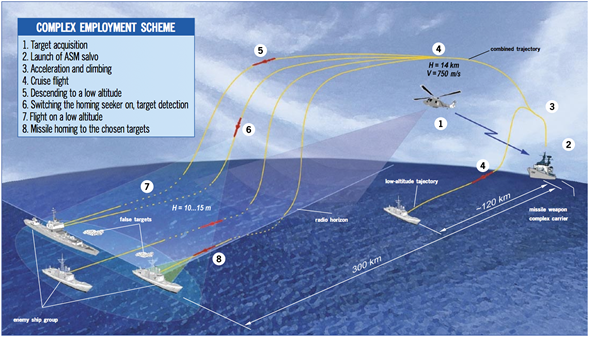

The bastion battery comprises eight twin-missile mobile launchers, command and control vehicles and logistics support trucks.

Přihlásit se k odběru:
Příspěvky (Atom)

